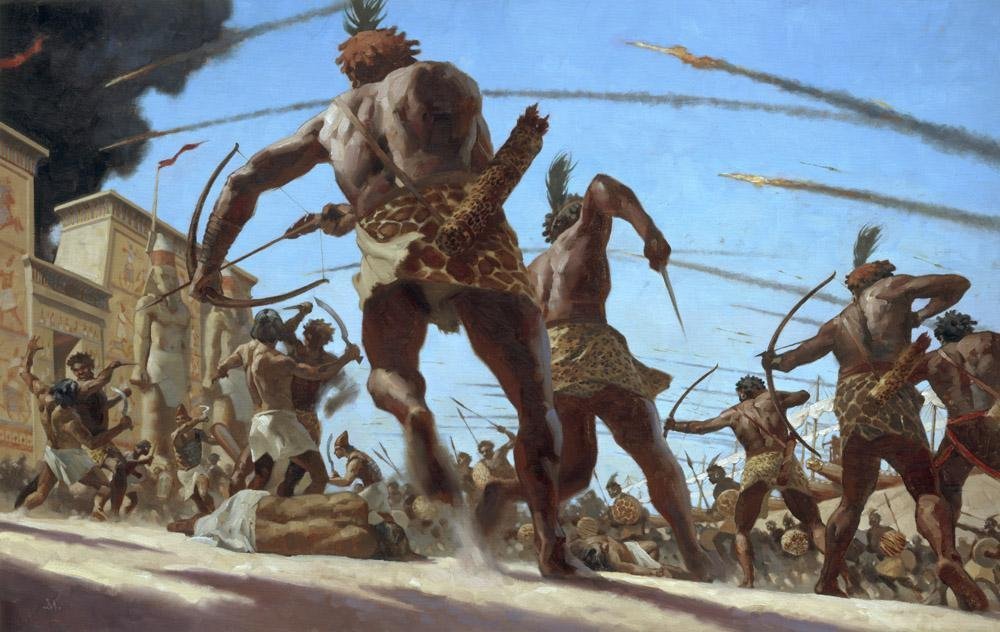Normally, dragons are more part of the high fantasy genre than what I'm going for with Khem. But I like them, and so thought I'd introduce them as part of the metal economy of the setting. Viola, dragons are the source of all good metals in Khem.
Dragons are always associated with metal, and therefore mining in Khem. Dragons, like the gods, have bones and scales of metal, with chemical compounds and elements mixed with their musculature. Dragon hunters seek not merely access to the lairs of dragons for the quantities of metal the dragon guards, or many scholars believe, are born from, but also to plunder their corpses for strong iron, pure gold and silver, or brass or copper. A rich deposit of ore generally contains many wyrmlings, or deeper in the depths, an adult dragon. Dragons are commonly found in the Mountains of Flame, and the Tanian Mountains east of the Karnak. Dragons are highly territorial, and focus more on fighting other dragons than worrying about mammals. Dragons are known not only to spring from the depths near deposits of ore, but also take over those not the territory of a dragon. The Pharaoh and kings often attempt to guard metal mines from the beasts, but oft unsuccessfully. Dragons seek most highly lairs around the ore they are born from (gold mines for gold dragons), but also hunt metals associated with them, especially if in large quantities. They like all metal, though, and will hunt or seek an alternative lair filled with any metal if that's the best they can do. Dragons eat sheep, goats, and men, but legends speak of their immortality in their metal-filled lairs. The exact ecology of the dragons is highly disputed by scholars, even the elementalists cannot quite fathom it.

The most common dragons in Khem are those of bronze, brass or copper, and these often reside in desert outcroppings with small deposits. These dragons are smaller, on average, than their precious-metal or iron cousins. Though variously called bronze or brass, they're almost invariably alloyed bodied and only their hue and coloring suggest one metal over another, though alchemists and mettalurgists can refine the component metals.
Next most common are the dragons of iron, often called red or rust dragons. In the north, these are more common than in the south, but many dwell in the Mountains of Flame near Khem. (Sometimes the barbarian northern lands are called the Ironlands for this reason). Iron dragons can generally breath fire or noxious fumes, but fewer are winged than among the southern dragons.
Rarer are gold and silver dragons, though these seem less aggressive than their fire-breathing cousins.
The most valued finds are dragon corpses found fallen in the desert or mountains. As so territorial, other dragons are normally the reason for these carcasses. The meat is fairly useless, but men will fight fiercely for these rich, relatively safe sources of metal. These free corpses lead to gold rushes with much violence, especially if found far from a local king or the Pharaoh's law.
Unless their lair is sought out, most dragon sightings will be younger wyrms that survived the cannibalistic fighting with their fellow young and have begun wandering in search of ore deposits unguarded by more powerful dragons.
Juvenile Brass Dragon: (based on the Adventurer Conqueror King dragon rules, which are the nastiest I've found for basic d&d games plus Lamentations assumptions) typical younger brass dragon, around 40 years old, roughly 2000 lbs, 16' long. HD 8 (d12), AC 18, claws d6/d6/2d8 bite, saves as F8, XP 1600, MR 7, MV 30'/fly 80'. Breath: scorching heat from its furnace-like 'breath' glands, 90' x 30' cone, 8d6 damage (save for half if in cone), 3x/day.
Young brass dragons like to ride the thermal desert winds searching for metals to add to their lairs. More rarely, they grow hungry and will eat a gazelle or sheep. They are cunning enough to be wary of organized men, but small groups of armed and armored soldiers are attractive for their equipment. They are also oft found sunning themselves on rocky outcroppings (1-2 in 6 if randomly encountered), but can 'smell' metal and are generally only surprised on 1 in 6 chance. In fights, the brass juvenile will try to scorch his prey to death from above, and tests morale after anytime it takes 10 hp or more; if guarding lair with its copper and bronze collection, it will only flee if failing morale and down to 10% of hp or less.
A juvenile's body is worth about 5,000 silver in value, if sold and transported (deduct costs of carrying heavy metal). Butchering the corpses to get metal bones requires skilled work, heat, and the carcass takes 1d4 weeks of labor per 5 laborers to mine. Keep in mind water sources are rare near their favored habitats. In it's lair, these young have generally gathered 2d6 x 1000 copper pieces (1/10 a silver's value), a fourth of which is in the form of statuary, armor, and weapons.












































